
Alfa Romeo has a colourful history dotted with truly remarkable motor cars, but the Fiat-owned manufacturer is currently on a drip-feed.
Its mainstream models have failed to create more than a blip in the sales charts and, bar the achingly beautiful but deeply-flawed 8C supercar, there’s been little to stir the hearts of the diehard Alfisti.
Until now, of course. With a carbonfibre tub, mid-mounted turbocharged four-cylinder engine and rear-wheel drive dynamics, the 4C offers a tantalising collection of ingredients, but can it be the brand’s promised comeback car?
Or is this little more than Italy’s answer to the Lotus Elise, a minimalist tool that only excels on the right road at the right time?
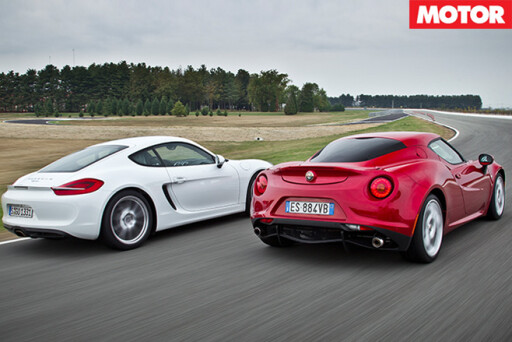 Michael Taylor covered the nitty-gritty of this potential automotive messiah in his first drive, so we won’t go over it again, but here’s the highlight reel: 176kW/350Nm, 895kg (dry), 0-100km/h in 4.5sec, AUD$80,000. Only 3500 units a year will be produced for the world market, with Australia initially likely to receive just 80 cars.
Michael Taylor covered the nitty-gritty of this potential automotive messiah in his first drive, so we won’t go over it again, but here’s the highlight reel: 176kW/350Nm, 895kg (dry), 0-100km/h in 4.5sec, AUD$80,000. Only 3500 units a year will be produced for the world market, with Australia initially likely to receive just 80 cars.
Its pace may give the 911 Carrera a fright, but the Porsche the 4C really has to overcome is the phenomenally capable Cayman.
On paper, it looks as though the Stuttgart marque may have an uphill battle on its hands: the Cayman trumps the Alfa with 202kW from its 2.7-litre flat-six, but will struggle to see which way the 4C went in a straight line, taking a relatively leisurely 5.7sec to dispatch the 0-100km/h sprint.
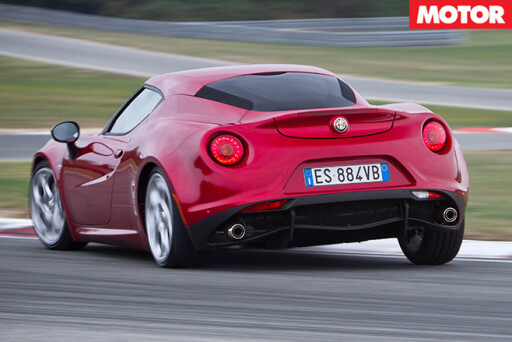 How come? Well, a 60Nm torque deficit doesn’t help, but the real story is in the two cars’ respective kerb weights. It’s not often a Porker seems too porky, but weighing in at a hefty 415kg more than the 4C, the Cayman is definitely the well-fed Clive Palmer to the 4C’s gangling and triathlon-addicted Tony Abbott.
How come? Well, a 60Nm torque deficit doesn’t help, but the real story is in the two cars’ respective kerb weights. It’s not often a Porker seems too porky, but weighing in at a hefty 415kg more than the 4C, the Cayman is definitely the well-fed Clive Palmer to the 4C’s gangling and triathlon-addicted Tony Abbott.
We start this test on the Alfa Romeo test track in Balocco – in the Porsche. The super-sweet, super balanced Cayman excels as there are no rough edges, no abrupt transitions and no nasty surprises – you could accept an incoming phone call while sliding through the esses. The steering is smooth and progressive, the light-footed handling easily modulated and the drivetrain performs in a flow.
If that all sounds a bit predictable, teutonic, boring even, then the 4C quickly provides an adrenaline-charged antidote. Driving the 4C on track is likely to involve more sweaty palms, heavy breathing and trembling fingertips than in the Cayman but, equally, the Alfa driver will also have a bigger grin more often.
Even with all the electronic aids deactivated, the 4C remains an interactive tool that never leaves you in any doubt as to what is going to happen next.
 Having said that, the Alfa is neither as intuitive nor as confidence-inspiring at the limit as the beautifully homogenous Porsche. The 4C’s steering inputs arrive at the rear wheels with a certain delay and they tend to unsettle the front wheels over bumps or at high speed to a greater extent than expected. In fact, it’s the unassisted steering that is the biggest hurdle.
Having said that, the Alfa is neither as intuitive nor as confidence-inspiring at the limit as the beautifully homogenous Porsche. The 4C’s steering inputs arrive at the rear wheels with a certain delay and they tend to unsettle the front wheels over bumps or at high speed to a greater extent than expected. In fact, it’s the unassisted steering that is the biggest hurdle.
The effort required is spot-on most of the time, but at parking speed the wheel threatens to freeze in your arms. And away from the track and out on the open road, tramlining raises its ugly head; it’s best to just leave the occasionally snappy front end alone and let it sort itself out like a vintage 911.
The Alfa R&D team consciously went down the hardcore avenue, but the 4C’s ride and stability suffer as a result next to the rock-solid yet nicely compliant Cayman.
In fact, approach these two from a pragmatic perspective and one car stands head and shoulders above the other.
 The 4C, particularly in stripped-down 895kg guise, is about as luxurious and practical as a paper maché tent; the cabin is primarily composed of hard black plastic, rear three-quarter vision is non-existent, the tiny boot aft of the engine will fry your luggage and the gear-selection buttons on the centre console are hard to reach and even harder to see.
The 4C, particularly in stripped-down 895kg guise, is about as luxurious and practical as a paper maché tent; the cabin is primarily composed of hard black plastic, rear three-quarter vision is non-existent, the tiny boot aft of the engine will fry your luggage and the gear-selection buttons on the centre console are hard to reach and even harder to see.
Head and shoulder room are not an issue, but climbing in and out of the 4C should be practised in private before you embarrass yourself in public.
In contrast, the Cayman is like a fully furnished luxury flat, with electronically adjustable seats, an ear-bleeding stereo and colour multimedia display, but such opulence incurs a hefty penalty at the weighbridge.
Carrying those extra kilos, in addition to lacking a force-fed torque curve, means that around town the Cayman needs to be belted in the hyperactive ‘Sport-plus’ mode simply to keep the red rocket in sight.
 Once the road starts to open and the revs start to rise, however, the contest becomes closer. Both cars top out at an indicated 267km/h, but while the Alfa retains its accelerative edge, the ability to stretch the Cayman’s 2.7-litre flat-six to a howling 7600rpm (the 4C revs to 6500 but it’s given its best by 5500rpm) and flick through seven speeds rather than six allows the Porsche to punch harder than its on-paper stats suggest.
Once the road starts to open and the revs start to rise, however, the contest becomes closer. Both cars top out at an indicated 267km/h, but while the Alfa retains its accelerative edge, the ability to stretch the Cayman’s 2.7-litre flat-six to a howling 7600rpm (the 4C revs to 6500 but it’s given its best by 5500rpm) and flick through seven speeds rather than six allows the Porsche to punch harder than its on-paper stats suggest.
What the Alfa’s turbocharged unit does give you, though, is flexibility. With maximum torque of 350Nm available from 2200-4250rpm, changing gear becomes an optional activity, while the Porsche demands that every last rev be used – get caught a gear too high in the Cayman and the 4C’s pretty Ferrari 458-esque rump will simply disappear into the distance.
The turbocharging also imbues that 1.7-litre four-pot with a unique soundtrack: it’s loud, possibly too loud, with the musicality of the base engine note embellished with furious turbocharger whine, wastegate sneezes and vicious cracks from the exhaust on full-throttle upshifts.
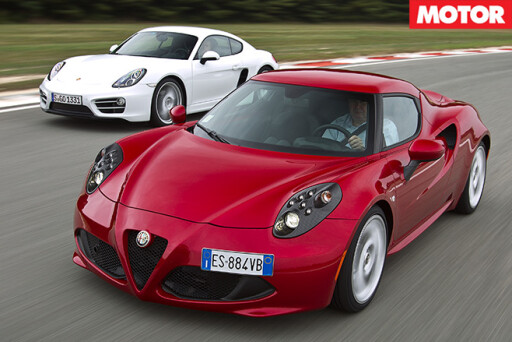 And so we could go on, the two protagonists trading performance punch for handling counter-punch. Their respective abilities are close enough to make deciding a definitive winner difficult, but, in reality, the two cars are so different in character that for most buyers it’ll be a case of loving one and hating the other.
And so we could go on, the two protagonists trading performance punch for handling counter-punch. Their respective abilities are close enough to make deciding a definitive winner difficult, but, in reality, the two cars are so different in character that for most buyers it’ll be a case of loving one and hating the other.
The Alfa is exceptionally pretty (bar those awful headlights, which will surely strike fear into arachnaphobes everywhere) with real centrefold appeal. It’s also almost always the faster car from A-to-B and more fun to drive – while your physical stamina lasts. And therein lies the problem.
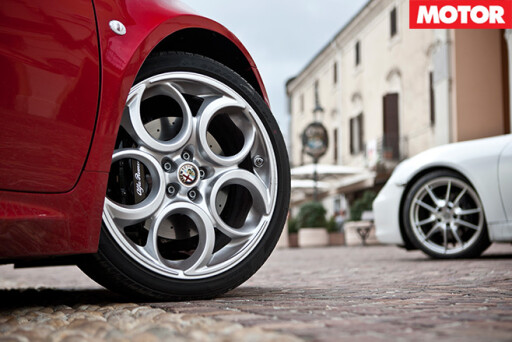 Conceptually, the 4C is a street-legal racing car, leaving you with rosy cheeks, sore palms, nervous feet and your subconciousness on fire. But by the afternoon of the test, the queue for the Alfa’s keys is down to the youngest member of the team. Us geriatrics need a break from the heat, the vibrations and the constant excitement.
Conceptually, the 4C is a street-legal racing car, leaving you with rosy cheeks, sore palms, nervous feet and your subconciousness on fire. But by the afternoon of the test, the queue for the Alfa’s keys is down to the youngest member of the team. Us geriatrics need a break from the heat, the vibrations and the constant excitement.
Enter the Cayman, with chairs designed for humans, not monkeys; with air-con that can do better than freezing the face while frying the toes; with suspension that doesn’t feel like you’re sitting on a skateboard. It’s the better 24/7 choice, a comfortable and convenient sports coupe for grown-ups.
And yet, as soon as parking space and funds permit a second car, the Alfa Romeo should be on every petrolhead’s shopping list.
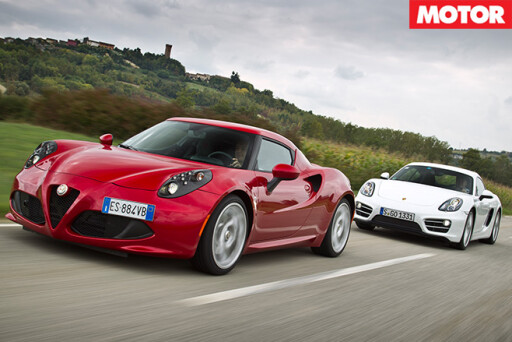 The 4C is everything its predecessor, the attractive but underwhelming Brera, was not: it is skin-over-bones light, focuses primarily on performance and handling and titillates every sense without depleting your bank account like those big-name supercars. It fuses a lightweight physique and heavyweight performance in a very special sports car experience.
The 4C is everything its predecessor, the attractive but underwhelming Brera, was not: it is skin-over-bones light, focuses primarily on performance and handling and titillates every sense without depleting your bank account like those big-name supercars. It fuses a lightweight physique and heavyweight performance in a very special sports car experience.
| PORSCHE CAYMAN | ALFA ROMEO 4C | |||||||
| Body | 2 door coupe | 2 door coupe | ||||||
| Drive | rear wheel | rear wheel | ||||||
| Engine | 2706cc flat-6, DOHC, 24v | 742cc 4cyl, DOHC, 16v, turbocharger | ||||||
| Bore/Stroke | 89.0 x 72.5mm | 83.0 x 80.5mm | ||||||
| Compression | 12.5:1 | 9.25:1 | ||||||
| Power | 202kW @ 7400rpm | 76kW @ 6000rpm | ||||||
| Torque | 290Nm @ 4500-6500rpm | 350Nm @ 2200-4250rpm | ||||||
| 0-100km/h | 5.7sec (claimed) | 4.5sec (claimed) | ||||||
| Top Speed | 264km/h (claimed) | 266km/h (claimed) | ||||||
| Fuel Consumption | 7.7L/100km (claimed) | 6.8L/100km (claimed) | ||||||
| Emissions | 180g/km CO2 (claimed) | 157g/km CO2 (claimed) | ||||||
| Kerb weight | 1340kg | 895kg (dry) | ||||||
| Power-to-weight | 151kW/tonne | 197kW/tonne (dry weight) | ||||||
| Transmission | 7-speed dual-clutch suspension struts, multi links, adaptive dampers, anti-roll bar (f/r) | 6-speed dual-clutch suspension double wishbones, coil springs, dampers, anti-roll bar (f); struts, coil springs, dampers (r) | ||||||
| Suspension | struts, multi links, adaptive dampers, anti-roll bar (f/r) | double wishbones, coil springs, dampers, anti-roll bar (f); struts, coil springs, dampers (r) | ||||||
| Length/width/height | 4380/1801/1294mm | 3989/1864/1183mm | ||||||
| Wheelbase | 2475mm | 2380mm | ||||||
| Tracks | 526/1536mm (f/r) | 1650/1605mm (f/r) | ||||||
| Steering | electrically assisted rack-and-pinion | unassisted rack-and-pinion | ||||||
| Brakes | 315mm ventilated/drilled discs, four-piston calipers (f); 299mm ventilated/drilled discs, four-piston calipers (r) | 305mm ventilated discs, four-piston calipers (f); 292mm ventilated discs, single-piston calipers (r) | ||||||
| Wheels | 20 x 8.0-inch (f); 20 x 9.0-inch (r) | 18 x 7.0-inch (f); 19 x 8.0-inch (r) | ||||||
| Tyres | Pirelli P Zero 235/35 ZR20 95Y (f); 265/35 ZR20 95 Y (r) | Pirelli P Zero 205/20 ZR18 91Y (f); 235/35 ZR19 91Y (r) | ||||||
| Price | $112,090 | $80,000 (TBC) | ||||||
| Positives | Superb ride/handling balance; revvy engine, efficiency; interior quality | Supercar looks and performance at a bargain price | ||||||
| Negatives | Engine lacks torque; not super fast; pricey options | Lack of refinement; interior quality; customer cars will weigh much more than 895kg | ||||||
| 4.5/5 | 4/5 |

COMMENTS